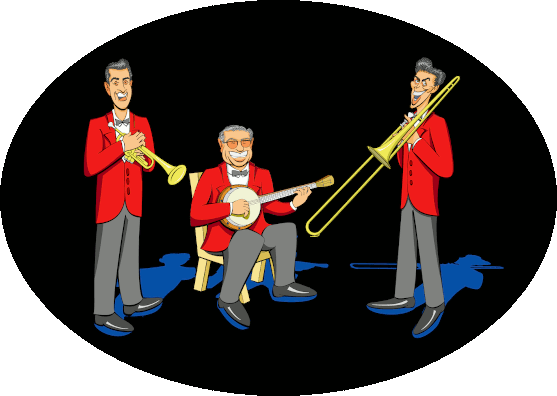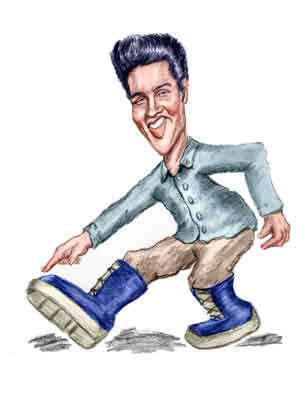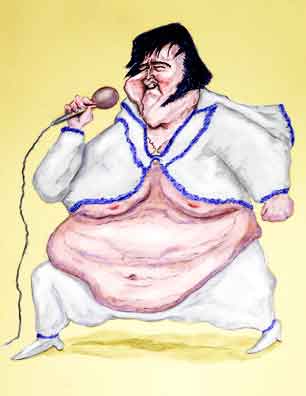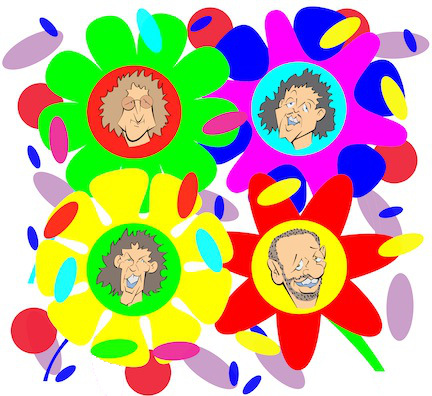Pete Fountain
Click Image to Zoom In and Out
"I told him the crack about the clarinet - 'an ill woodwind that nobody blows good'. That made him laugh fit to bust."
- Live and Let Die, Ian Fleming
Well, we can cut Ian some slack when he wrote this more lamentable of the James Bond novels.1 After all, Ian certainly wouldn't have heard the music of Pete Fountain since the book was only published the same year - 1954 - that Pete cut his first records.
Footnote
Lest this classification of the second James novel draw the ire of many a 007 fan, it is not to detract from the book's plot or Ian's writing ability.
But we have to admit that Ian was still a product of his times and economic class, and for now we'll just mention that in Live and Let Die, a good part of which is set in Harlem in New York, he seems determined to omit no stereotype. The irony is that Ian was trying to show his open-mindedness and toleration. In briefing Bond on the mission, Bond's boss, Admiral Sir Miles Messervy (always referred to as M.) makes the comment how the black race was "just beginning to throw up geniuses in all the professions - scientists, doctors, writers" and adds "They've got plenty of brains and ability and guts". But now he says they've also turned out a master criminal.
Naturally Bond adds his opinion that the African Americans are "pretty law-abiding chaps I should have thought" - and then throws in yet one more stereotype - "except when they've drunk too much."
This said by James Bond - whose medical report in Thunderball states his daily consumption included sixty cigarettes and half a fifth of hard liquor and who in the novel Goldfinger in one evening downs four double bourbons, two double martinis, and a pint of pink champagne.
And it wasn't until 1958 that Pete rose to national stardom. That's when he became a band member and featured soloist on the The Lawrence Welk Show.
What is this? (To quote Shakespeare.2) It's Pete's playing on The Lawrence Welk Show that led to his fame?
Footnote
Love's Labor's Lost, Act V, Scene II, William Shakespeare, First Folio, Edward Blount and Isaac Jaggard (Editors and Publishers), 1623.
It is indeed.3 Pete Fountain became nationally known only after he became a member of Lawrence Welk's bubbly band. But Pete found that the rise to stardom could be nerve wracking. A major problem was simply the fan mail. It literally poured in and he was too nice a guy not to try to answer it all, and at the time he couldn't afford a secretary.
Footnote
All's Well That Ends Well, Act II, Scene III, William Shakespeare, First Folio, Edward Blount and Isaac Jaggard (Editors and Publishers), 1623.
Perhaps it was the strain being a stellar player with one of the most popular bands in America.4, but within a couple of years, Pete had left Lawrence's show, and began playing what he really liked - Dixieland or today what is called "traditional jazz". Or rather he returned to playing Dixieland. After all Pete came from New Orleans.
Footnote
Although the butt of many a "and-a-one-and-a-two-and-a-three" jokes, The Lawrence Welk Show ran for twenty years starting in 1951. It only fell in 1971 to what was called The Great Rural Purge.
In 1971 the network bigwigs had decided to cancel anything with a rural theme. Long time favorites toppled: Green Acres, The Andy Griffith Show (by then called Mayberry, RFD), Petticoat Junction, Lassie, Mr. Ed, The Beverly Hillbillies, and the variety show Hee-Haw.
As to why the Lawrence Welk Show was caught in such a purge, it seems that the bigwigs' definition of "rural" was somewhat broader than colloquial use. Not only were long time westerns - Gunsmoke and Bonanza - whacked from the airways, but even nature and animal shows like Mutual of Omaha's Wild Kingdom were scotched. The purge quickly expanded to other long running programs. These included The Original Amateur Hour, My Three Sons, Family Affair, The Jackie Gleason Show, Hogan's Heroes, The Red Skelton Show, and the even the iconic Ed Sullivan Show.
And as we said, The Lawrence Welk Show.
But why such a drastic purge in the first place?
The rationale for dumping such popular shows was simplistic as are many management decisions based on hypothetical and theory driven business models. But by the 1970's it was no longer just the ratings that counted to keep a show on the air. Instead it was the kind of ratings that mattered.
A rating didn't count unless it came from the slice of the population that the executives thought had the money to spend and were also gullible enough to get sucked in by the commercials that even then were taking up more and more of the broadcast time. Future programming was to focus on kids with deep pockets and their parents who had even deeper pockets.
The Rural of 1971 also coincided with the major networks getting out of the syndication business - that is the networks quit licensing shows to air at the discretion of individual stations. The TV stations were going to broadcast what the networks wanted. If they didn't like what was offered, well, that was tough bananas.
But the executives had forgotten that there were now independent production companies floating around whose business was to create programs and sell them independently to the television stations. And there were also lots of cancelled programs that people still wanted to watch. And so nothing was easier than to take the old programs and put them into syndication.
One of those to make the transition was, yes, The Lawrence Welk Show. With no trouble Lawrence and his producers dug up he funds to film the show and distribute it to the stations that wanted it. And that was quite a few. Lawrence kept going for over ten years and finally closed down in 1982.
Perhaps what happened was simple poetic justice. The massive purge based on perceived advertisement revenues or simply the personal tastes of the executives was the beginning of the end of the oligarchy of the Big Three Networks. Since so many shows went into syndication, it became clear that specialized independent productions could compete and even thrive against The Big Three, who after the rise of cable television found themselves sitting in the back seat. Some shows enjoyed greater profits and longer life than Lawrence Welk. For instance, Hee-Haw ran in syndication for another 25 years.
Pete - his real name was Pierre - took up the clarinet as a kid and was playing professionally by the time he was in high school. He made $150 a week but because he stayed up so late playing, he kept falling asleep in class. He dropped out in his senior year but that didn't bother him since he was already earning more than his teachers. In 1951 he married Beverly Lang and unlike many show-biz marriages, this one lasted.
After high school he played with a band started by Frank and Fred Assunto. After some fiddling about for a name, they finally decided - or rather Frank and Fred's mom, Maria, did - on The Dukes of Dixieland. Pete is featured on some of the early Dukes' singles before they went on to fame and fortune on the high fidelity stereophonic LP's cut in the 1950's and 60's. Pete soon left the Dukes to play with a friend from high school and emerging star, Al Hirt.
Al Hirt
Why play with Lawrence?

The Dukes of Dixieland
Sans Pete
But if you're playing with Al Hirt, why go and play with Lawrence Welk? Well, Al wasn't a big star yet, and certainly money may have been a factor. But there was no doubt that playing on a nationally broadcast television show would bring what every performing artist wants: exposure. So in 1957 when Lawrence learned of Pete's ability and asked him to come play in Los Angeles, Pete didn't have to think twice.
Lawrence had particular ideas of how his players should look and Pete didn't quite fit the mold. But Pete was never a contrarian and he agreed to trim back his goatee, not wear his glasses, and put on a toupee.
But we have to be honest. Pete and Lawrence just didn't like the same type of music. And Lawrence thought Pete jazzed songs up too much. In particular, his hep version of "Silver Bells" on a Christmas Special was too much for Lawrence to take. Besides Pete wanted to get back to New Orleans - but not before he was able to get Al as a guest star on the show. Pete finally left after the 1958 season.
The Young Man From Memphis

Before

After
Back in Louisiana, Pete was now a TV star and a popular jazzman. In 1960 he opened his own club on Bourbon Street not far from Al's. Those were great years. You could take in the show at Al Hirt's and then walk a short distance off and see Pete Fountain.
Then in 1977 Pete opened a new club in the swank Hilton Riverside Hotel. He remained there over a quarter of a century until ill-health forced him to cut back - but not eliminate - his performing.
It had been easy for Pete to land record contracts, not only because his music was good but because they also sold well. By one count Pete issued over 125 recordings although he made or was featured on hundreds more.5 Most of those that were released under his own name were during the 1960's,
Footnote
As we said, Pete's earliest recording under his own name in 1954. However, one of his earlier singles with the Dukes of Dixieland was from 1951.

Plus The Fab Four Liverpudlians
The reason Pete cut back his recording in the 70's was mostly due to the decline in the popularity of jazz. Starting in the mid-1950's other music had moved in, particularly the gospel and blues inspired songs of a swiveled hipped young man from Memphis. And if people thought Elvis was competition for jazz, it was nothing compared to what happened in 1964 when four young Liverpudlians with funny haircuts came over.
But Pete kept playing. From 1964 to 1990, Pete was a guest on The Tonight Show with Johnny Carson a whopping 39 times. In 1976 he and Al were part of the half time entertainment for the Super Bowl XII, and Pete even appeared on the folk music television series, Hootenanny.6 Then in 1987 he was asked to perform when a chap named Karol Jozef Wojtyla came to New Orleans for a visit.
Footnote
For some reason, Al Hirt, who had a number of pop hits - "Java", "Cotton Candy", "Sugar Lips" - never was on Hootenanny nor its more rock oriented sister show, Shindig!.
But in all of Pete's long years of playing music, everyone must lament one oversight. How it happened, no one knows. After all, the honor was bestowed on stars as varied as Buddy Rich, Kenny Rogers, Roy Clark, Arlo Guthrie, Joel Grey, Johnny Cash, Rudolf Nureyev, Dizzy Gillespie, Roy Rogers and Dale Evans, Beverly Sills, Leslie Uggams, Lena Horne, Andy Williams, Vincent Price, Mac Davis, Shirley Bassey, and Jean-Pierre Rampal.
Yes. Pete never hosted The Muppet Show.
References and Further Reading
"Pete Fountain" Discography of American Historical Recordings, University of California-Santa Barbara.
"Fame is Nice But ...", Harold Heffernan, The [Washington, D. C.] Sunday Star, May 18, 1958, p 230 About Evening star. [v, January 4, 1898, p. 7.
"What Gave Early New Orleans Jazz Clarinets Their Unique Sound?", Acoustical Society of America, Phys.Org.
Sounds of the Metropolis: The 19th Century Popular Music Revolution in London, New York, Paris and Vienna, Derek B. Scott, Oxford University Press, 2011.
"History of Ragtime", Library of Congress.
"Ching Ling Foo's Big Hit at Polis", The Bridgeport [Connecticut] Evening Farmer, January 21, 1913, Page 4.
"Ragtime from Wagner - Also in Part from Mozart, Beethoven, and Other Great Masters", Gilpin [Colorado] Observer, July 12, 1900, (Reprint July 12, 1900), p. 4.
"At the Orpheum", The San Francisco Call, January 4, 1898, p. 7.
"Pete Fountain", Billboard.
"Pete Fountain", Internet Movie Data Base.
"Pete Fountain, New Orleans' Clarinet-Playing Musical Ambassador", John Pope, The Times-Picayune, NOLA, August 6, 2016.
"Pier 600", Louisiana Dance Halls.
"General Gas - 1951 Pete Fountain with The Dukes of Dixieland (Assunto Brothers)", Deano Assunto, Aug 6, 2016.
"Brass Bands of the Civil War", Jari Villanueva, JV Music.
"Jazz Has Become The Least-Popular Genre In The U.S.", David La Rosa, Jazzline News, March 9, 2015.
"Pete Fountain", Find-a-Grave, December 14, 1999.
"Pete Fountain", NgramViewer, Google Books.
Live and Let Die, Ian Fleming, Johnathan Cape, 1953.